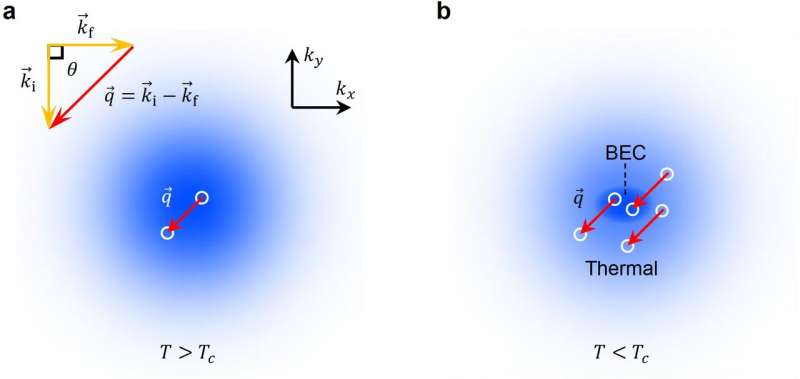January 16, 2023 feature
This article has been reviewed according to Science X's editorial process and policies. Editors have highlighted the following attributes while ensuring the content's credibility:
fact-checked
peer-reviewed publication
trusted source
proofread
The first experimental bosonic stimulation of atom-light scattering in an ultracold gas

Bosons, one of the two fundamental classes of particles, have been the focus of countless physics studies. When bosonic particles are transitioning into an already occupied final quantum state, the rate of this transition is enhanced by its so-called "occupation number," an effect known as bosonic stimulation. The appearance of bosonic stimulation in light scattering processes was first predicted over three decades ago, yet directly observing it in experimental settings has so far proved challenging.
Researchers at the MIT-Harvard Center for Ultracold Atoms have recently observed bosonic enhanced light scattering in an ultracold gas for the first time. Their findings, published in Nature Physics, could open new exciting possibilities for the study of bosonic systems.
"For bosons, the transition rate into an already occupied quantum state is enhanced by its occupation number: the effect of bosonic stimulation," Yu-Kun Lu, one of the researchers who carried out the study, told Phys.org.
"While bosonic stimulation was observed in various forms, the bosonic stimulation of light scattering was predicted more than 30 years ago but has proven elusive to direct observation. In simple terms, if one shines light on an ideal Bose gas perturbatively and observes an enhancement of scattered light when approaching quantum degeneracy, that would be the 'smoking gun' evidence of bosonic enhancement."
To conduct their experiment, Lu and his colleagues prepared an ultracold cloud of 23Na gas at a high density. They then shined a light onto it and measured the number of scattered photons originating from the system.
They found that scattering of photons was already enhanced before the system transitioned into a Bose-Einstein condensate (BEC). This enhancement, however, become even greater below the phase transition point, which is what theory predicts would occur in the presence of bosonic stimulation.
"We observed enhancement of light scattering already above the BEC phase transition and a more pronounced enhancement below the phase transition," Lu explained. "By comparing the data with theoretical prediction, we discovered that the interaction between atoms can also affect light scattering, especially below the phase transition. Furthermore, we showed that for a multi-level system prepared in a single internal state, the bosonic enhancement occurs only for Rayleigh scattering but not for Raman scattering."
The recent study by Lu and his colleagues offers the first experimental of bosonic stimulation of atom-light scattering in an ultracold gas. The team's observations clearly demonstrate how quantum statistics and interactions can modify the optical properties of a Bose gas.
"Understanding the interplay between quantum statistics, interaction, and phase transition in light scattering processes is not only of fundamental interest but is also crucial for quantitative diagnostics of bosonic systems using optical methods," Lu added. "In our future work, it would be promising to study bosonic enhancement of light scattering in a box potential because of the absence of density inhomogeneity. In that case, the enhancement effect will be larger, and the study of the interaction effect will be more straightforward."
In their next studies, the researchers also hope to use light scattering to characterize strongly interacting systems, including systems with strong dipolar interactions, which are anisotropic and long-range. This could advance the current understanding of these strongly interacting systems, while also providing vital experimental data that could help to verify theoretical predictions.
More information: Bosonic stimulation of atom–light scattering in an ultracold gas. Nature Physics(2022). DOI: 10.1038/s41567-022-01846-y.
Journal information: Nature Physics
© 2023 Science X Network




















